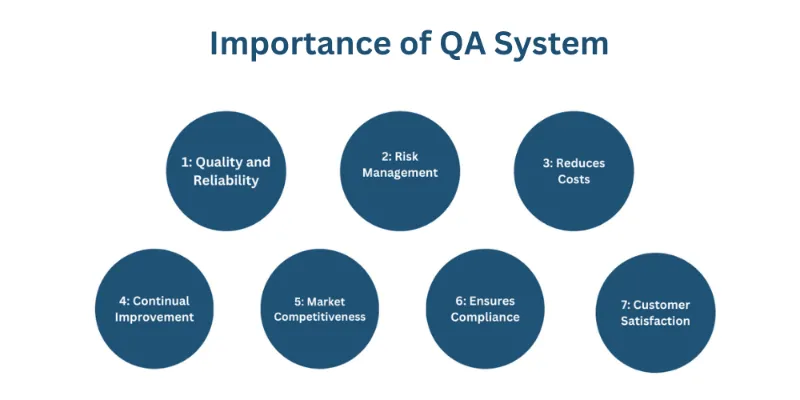QA System: The Key to Delivering High-Quality Software
A QA system is a systematic collection of processes and practices that not only scrutinizes every phase of software development—from planning and design to testing and deployment—but also ensures that each product adheres to the highest standards of quality. The primary goal of a QA system is to detect and correct issues before the software reaches the end user, thereby minimizing bugs, enhancing performance, and ultimately ensuring user satisfaction. Through a well-implemented QA system, businesses can maintain the integrity of their software, mitigate risks associated with software failures, and uphold their reputation by consistently delivering products that meet or exceed customer expectations.

This blog delves into what a QA system involves, its crucial processes, and the tools that enhance its effectiveness.
What is a QA System?
A Quality Assurance system comprises policies, procedures, and tools designed to help teams ensure that a software product is of the highest quality. This section will explain the key components of a QA system, including automated testing tools, manual testing methodologies, and the roles of QA analysts and engineers.
Why is a QA System Important?
A Quality Assurance (QA) system is crucial for several reasons in the development and delivery of software products and services:

-
Ensures Quality and Reliability: A QA system helps ensure that the software meets the desired quality standards and performs reliably under various conditions. This can help prevent defects that could potentially cause system failures or user dissatisfaction.
-
Reduces Costs: By catching defects early in the software development lifecycle, a QA system can save costs associated with fixing bugs post-release, which are often much higher than fixing them earlier.
-
Improves Customer Satisfaction: Software that has gone through rigorous QA testing is less likely to have bugs, leading to higher customer satisfaction. Satisfied customers are more likely to be repeat customers and recommend the product to others.
-
Ensures Compliance: For many industries, particularly those that are heavily regulated like healthcare and finance, software must adhere to specific regulatory standards. A QA system ensures compliance with these regulations, avoiding legal issues and potential fines.
-
Facilitates Market Competitiveness: By ensuring that a product is stable, functional, and meets customer expectations, a QA system can help a company maintain its competitive edge in the market.
-
Supports Continual Improvement: QA systems help gather feedback from testing and use it to make continuous improvements in the software, which can lead to better product quality and performance over time.
-
Risk Management: It plays a critical role in risk management by identifying potential issues and vulnerabilities before the software is deployed, helping to mitigate risks associated with software failures.
Key Processes in a QA System
The key processes in a Quality Assurance (QA) system typically include several structured steps that ensure software quality from conception to release. Here are the fundamental stages:
-
Requirement Analysis: Understanding and documenting what is required from the software.
-
Test Planning: Crafting a strategy that covers what needs to be tested, how testing will be carried out, and who will perform the tests.
-
Test Case Development: Writing specific cases that ensure every aspect of the software is covered.
-
Testing Phases: Executing various types of tests such as unit tests, integration tests, system tests, and acceptance tests.
-
Bug Tracking and Reporting: Managing and documenting bugs effectively using tools like JIRA or Bugzilla.
-
Feedback Loop: Incorporating feedback from QA processes back into the development cycle to enhance the product further.
Tools and Technologies Used in QA Systems
Quality Assurance (QA) systems leverage a variety of tools and technologies to ensure that software meets and maintains a high standard of quality. Here are some key tools and technologies commonly used in QA systems:

-
Test Management Tools:
Examples: TestRail, Zephyr, and QTestPurpose: Manage test cases, plans, and runs; organize testing efforts and track results in one centralized location.
-
Automated Testing Tools:
Examples: Selenium, QuickTest Professional (QTP), and TestCompletePurpose: Automate the execution of test cases, reduce the manual testing effort, and increase test coverage.
-
Performance Testing Tools:
Examples: LoadRunner, JMeter, and Apache BenchPurpose: Simulate multiple users or high loads to test how the system behaves under stress and measure performance metrics.
-
Security Testing Tools:
Examples: OWASP ZAP, Fortify, and Burp SuitePurpose: Identify vulnerabilities in software applications, such as SQL injection, XSS, and security breaches.
-
Bug Tracking Tools:
Examples: JIRA, Bugzilla, and MantisPurpose: Track and manage defects; facilitate communication among QA teams, developers, and other stakeholders about issues.
-
API Testing Tools:
Examples: Postman, SoapUI, and SwaggerPurpose: Test the functionality, reliability, performance, and security of APIs, which are crucial for integrating different software systems.
-
Mobile Testing Tools:
Examples: Appium, Espresso, and Xamarin.UITestPurpose: Test mobile applications across different devices and operating systems to ensure they function correctly.
-
Continuous Integration/Continuous Deployment (CI/CD) Tools:
Examples: Jenkins, CircleCI, and Travis CIPurpose: Automate the integration of code changes and streamline the testing and deployment processes, improving the speed and quality of development cycles.
-
Version Control Systems:
Examples: Git, SVN, and MercurialPurpose: Manage and track changes to the software's codebase, allowing teams to collaborate more effectively and revert to earlier versions if needed.
-
Cross-Browser Testing Tools:
Examples: BrowserStack, Sauce Labs, and CrossBrowserTestingPurpose: Ensure that web applications provide a consistent experience across all browsers and devices by testing them under various configurations.
QA system is not just a necessity but a major asset for any software development project. It ensures that software products are not only defect-free but also meet the highest standards of quality demanded by stakeholders and users alike.
Why Choose AMREP Mexico for Your QA System Needs?
Implementing a robust QA system is crucial for delivering high-quality software products that meet user expectations and industry standards. By integrating key processes, advanced tools, and a skilled QA team, your business can ensure efficiency, reduce risks, and maintain a competitive edge in the market.
At AMREP Mexico, we specialize in providing comprehensive QA solutions tailored to your business needs. Whether you're looking to enhance product quality, improve compliance, or boost customer satisfaction, our experienced team is here to help you achieve your goals. Contact us today to learn more about how we can support your software quality assurance journey.


